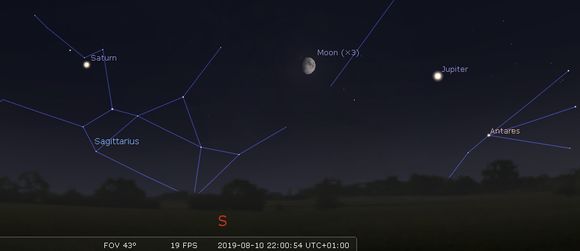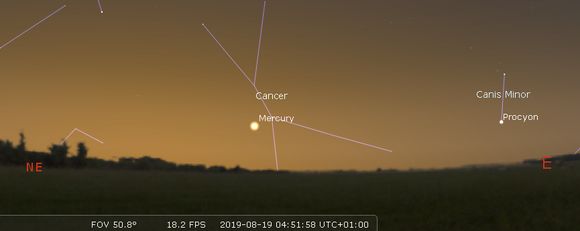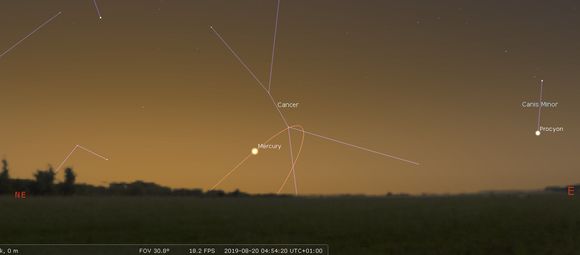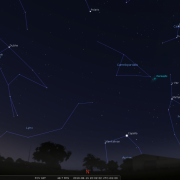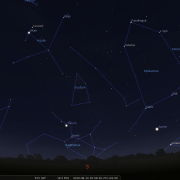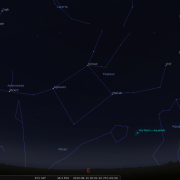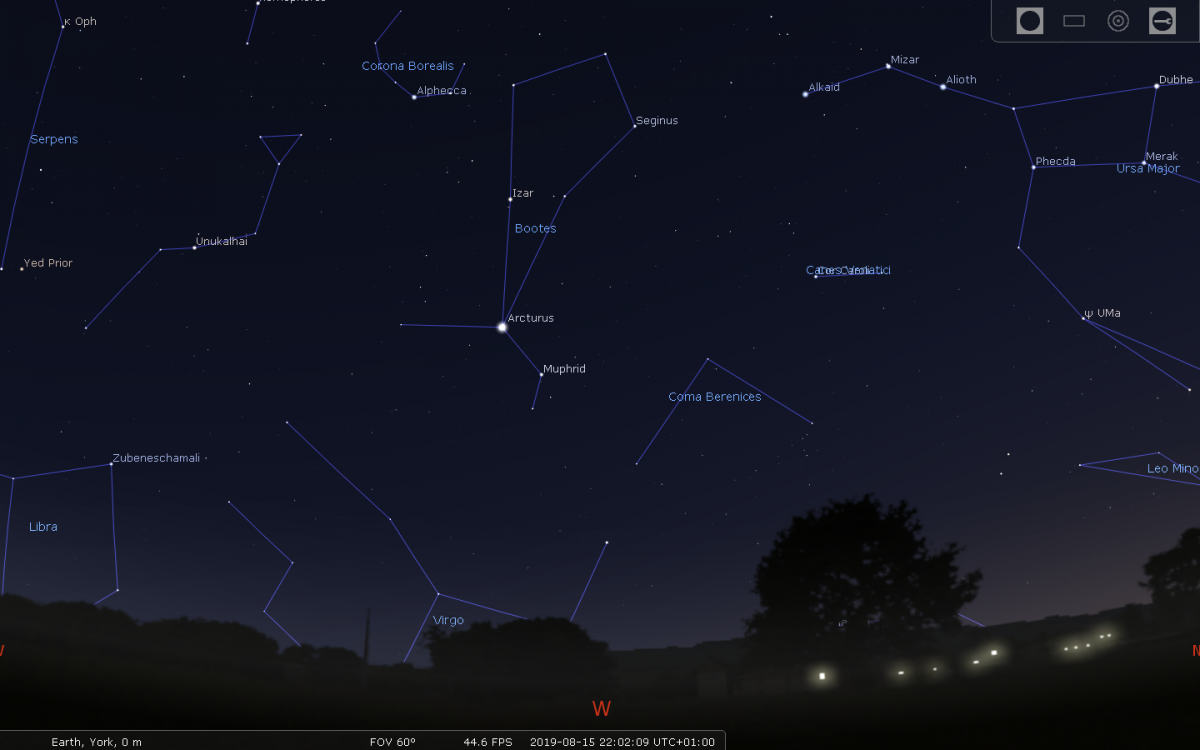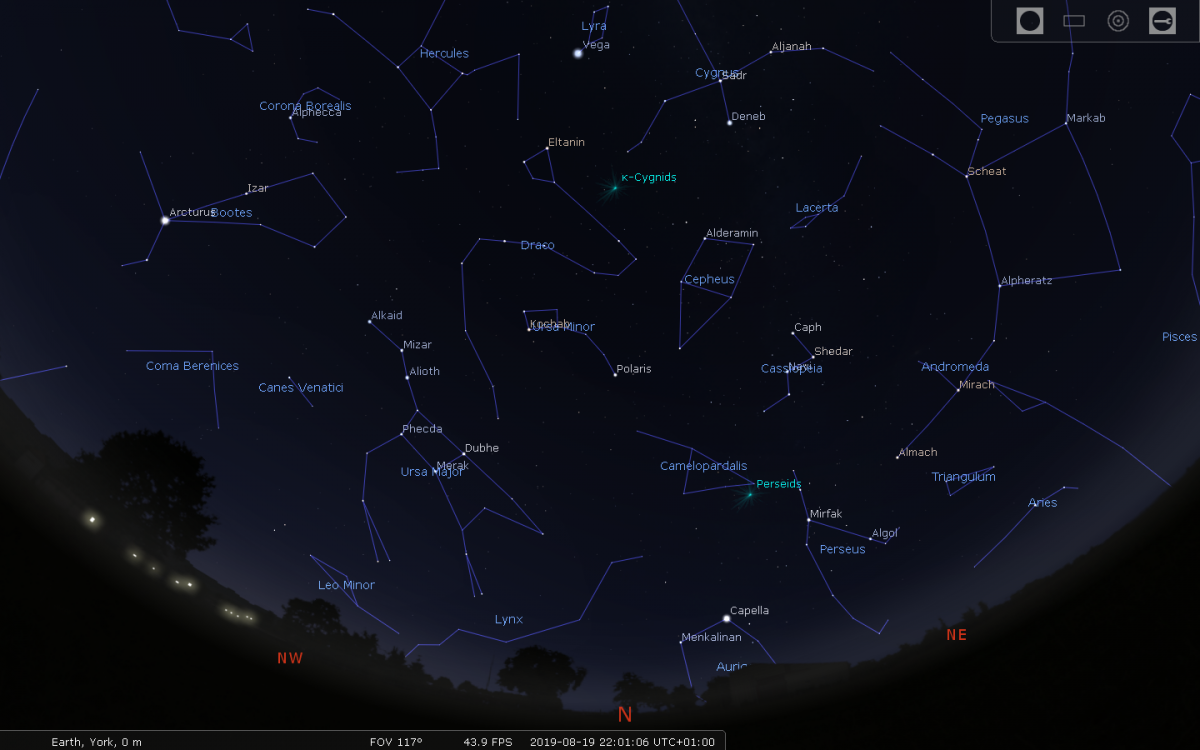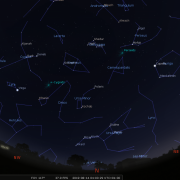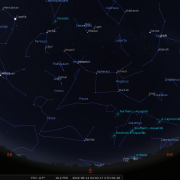In this month's Sky Notes:
Planetary Skylights
Three naked eye planets dominate this month; Jupiter and Saturn in the late evening sky, and Mercury in the dawn sky.

Jupiter is visible as soon as skies become dark enough and at Magnitude -2.5 is the brightest point in the night sky. Look for it across in the SSW as dusk falls not too far above the horizon residing in the southern most reaches of Ophiuchus. Have patience at the eyepiece when observing, waiting for those moments of steady seeing.
Look for the belts across the disk and when turned in our direction the great red spot, residing on the south equatorial belt. Consensus of data and observations do show that the GRS has shrunk by well over a third in the last decade and is being closely watched by astronomers to see whether this will continue. In the eyepiece it resembles a pale oval.
The most dynamic aspect of the Jovian system, the four Galilean moons, certainly warrants attention, with an ever changing configuration noticeable even over the course of a few hours.
On August 27th Jupiter again has a very close encounter with the deep sky object NGC 6235, a magnitude 9 globular cluster some 37,000 light-years distant.
Galilean moon shadow transits
- Io, 30/31st: ends at 21:06h
- Europa: 3/4th: 21:00–23:09h.
Great Red Spot visibility on Jupiter’s Disk
- 2/3rd: 23:30–01:17h
- 5/6th: 22:47–Central Meridian
- 7/8th: 22:30–00:25h
- 10/11th: 22:00h–Central Meridian
- 12/13th: 23:30h
- 17/18th: transits 22:43h
- 22/23rd: transits 21:52h
- 24/25th: transits 23:30h
- 27/28th: transits 21:00h
- 29/30th: transits 23:40h.
The Moon lies nearby Jupiter in the sky on the 9th.
 The Moon lies nearby Jupiter in the sky on the 9th.
The Moon lies nearby Jupiter in the sky on the 9th.
 Having reached opposition last month Saturn is actually better placed for observations at sensible hours during the comings months. Following Jupiter’s across the south by a few hours, Saturn will be on show low in the SE by 21:00h by the start of August arcing low across the south over the course of the night. Currently visible at Magnitude +0.1, Saturn is quite prominent to naked eye. Like Jupiter, observations of Saturn are somewhat compromised due to the low altitude, but patience at the eyepiece will be rewarded with the glorious rings evident in modest telescopes. The two main rings ring A and ring B, separated by the Cassini division are the most evident. Saturn’s largest moon; Titan, is visible as a speck of light nearby. Our moon lies in proximity to Saturn in the sky on the 11th/12th.
Having reached opposition last month Saturn is actually better placed for observations at sensible hours during the comings months. Following Jupiter’s across the south by a few hours, Saturn will be on show low in the SE by 21:00h by the start of August arcing low across the south over the course of the night. Currently visible at Magnitude +0.1, Saturn is quite prominent to naked eye. Like Jupiter, observations of Saturn are somewhat compromised due to the low altitude, but patience at the eyepiece will be rewarded with the glorious rings evident in modest telescopes. The two main rings ring A and ring B, separated by the Cassini division are the most evident. Saturn’s largest moon; Titan, is visible as a speck of light nearby. Our moon lies in proximity to Saturn in the sky on the 11th/12th.
 Elusive Mercury has a fine morning apparition lasting nearly all month. It will be easiest to spot between the 17th and 23rd approximately 10 degrees above the ENE horizon around 45 minutes before sunrise. For morning apparitions Mercury always appears brightest towards the end, the downside being it will then be very low. An unobstructed aspect is required, but given clear dawn skies Mercury should be evident to the naked eye. Perhaps use binoculars to help pick it out of the dawn twilight initially.
Elusive Mercury has a fine morning apparition lasting nearly all month. It will be easiest to spot between the 17th and 23rd approximately 10 degrees above the ENE horizon around 45 minutes before sunrise. For morning apparitions Mercury always appears brightest towards the end, the downside being it will then be very low. An unobstructed aspect is required, but given clear dawn skies Mercury should be evident to the naked eye. Perhaps use binoculars to help pick it out of the dawn twilight initially.
Meteors

August means shooting stars on the astronomical calendar with the annual Perseid meteor shower reaching a peak. The Perseids are one of the more reliable meteor showers, and given the time of year undoubtedly the most widely observed by the general public. Conditions this year however will not be ideal, with the moon just a few days off full, drowning out many of the fainter meteors.
Sometimes known as "The tears of St. Lawrence"; the martyred Christian deacon whose feast day falls on Aug 10th, just two days before the Perseids peak, these particular ‘tears’, like the majority of meteor showers, are composed of debris deposited over many thousands of years by periodic comets. Perseids are associated with comet Swift Tuttle which takes around 130 years to orbit the Sun. Perseid meteoroids are not dissimilar in size and density to that of instant coffee granules with the occasional pea or marble sized fragment. Each August, Earth encounters various strands of the Swift-Tuttle debris stream giving rise to the eagerly anticipated shooting stars.
Perseid meteoroids penetrate the upper atmosphere 60 miles above us at speeds of 43miles/second, interacting with atoms as they do so, before becoming ionised and releasing a packet of light. It is this brief luminous flash we call a meteor. Particularly bright examples often leave behind persistent ionisation trails in their wake, the classic shooting star. The radiant of the shower: the location in the sky from which the meteors appear to emanate, lies within the constellation of Perseus, which in August is rising in the north east during the evening. Perseid activity is highest from Aug 8th-15th reaching a peak this year over the night of Aug 12/13th.
Under ideal conditions the zenith hourly rate (ZHR) for the Perseids is typically 80-100, but moonlight will seriously restrict numbers this year to under 15 per hour, perhaps rising to 30 plus in the hour before dawn on the 13th.If observing view in areas of the sky a good hand span away from Perseus and around between 40-70 degrees above the horizon. Good luck.
August 2019 Sky Charts
|
Looking North
Mid-August - 22:00h |
Looking South |
|
Looking East
Mid-August - 22:00h |
Looking West
Mid-August - 22:00h |
|
Northern Aspect
Mid-August - 22:00h |
Southern Aspect
Mid-August - 22:00h |
| Looking North (Early) Mid-August - 04:00h |
Looking South (Early) Mid-August - 04:00h |
Additional Image Credits:
- Planets and Comets where not otherwise mentioned: NASA
- Sky Charts: Stellarium Software
- Log in to post comments

